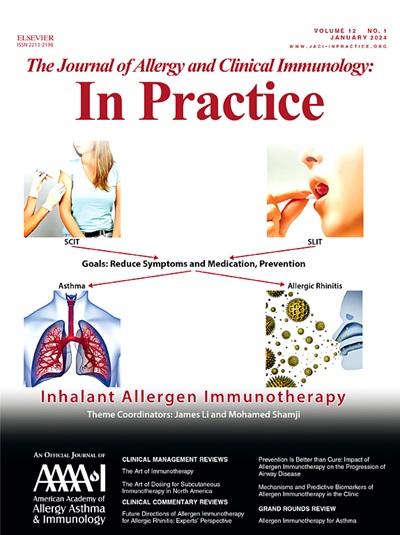烘焙牛奶调节儿童牛奶过敏:表型,年龄,摄入量的影响。
IF 6.6
1区 医学
Q1 ALLERGY
Journal of Allergy and Clinical Immunology-In Practice
Pub Date : 2025-09-01
DOI:10.1016/j.jaip.2025.06.011
引用次数: 0
摘要
背景:有限的证据表明,烘焙牛奶(BM)摄入加速牛奶过敏(CMA)的解决或调节烘焙牛奶耐受(BMT)和烘焙牛奶过敏(BMA)表型的免疫。目的:本研究评估BM引入的有效性、安全性和免疫效应,重点关注BMT定期摄入和BMA低剂量摄入及其对耐受性发展的影响。方法:一项前瞻性研究,包括12-72月龄的儿童,口腔食物挑战(OFC)证实了CMA。根据BM-OFC结果将CMA患儿分为BMT或BMA表型。BMT患儿被随机分为两组:B2组(每日摄入0.55 g BMP)和C2组(严格避免BM)。耐受最小剂量的BMA儿童同样随机分配:B1(每日摄入0.0375 g BMP)和C1(严格避免BM)。基线(T0)和12个月(T1)的评估包括皮肤点刺试验(SPT)、特异性ige (sIgE)、特异性igg4 (sIgG4)、嗜碱性粒细胞激活试验(BAT)和t细胞细胞因子谱。BM剂量在6个月时翻了一番,CM-OFC证实了T1时的结果。结果:共纳入确诊CMA患者50例,其中BMT 32例,BMA 18例。B2组每日BM摄入量显著提高了对CM的耐受性(77.2% vs . C2组40%,p < 0.05),安全性提高,SPT和sIgE标志物显著降低。反应性阈值增加了9倍(0.9 g vs 0.05 g)。B1组的耐受性没有明显增加。9.3%发生轻度家庭反应。耐受性的预测因素包括早期(结论:早期BM引入似乎支持BMT中CMA的解决,并可能提高安全性,特别是在幼儿中。定期服用BM可以带来更好的结果,而生物标志物为个性化管理提供了有价值的见解。本文章由计算机程序翻译,如有差异,请以英文原文为准。
Baked Milk Modulates Cow’s Milk Allergy in Children: Impact of Phenotype, Age, and Intake
Background
Limited evidence indicates that baked milk (BM) intake accelerates cow's milk allergy (CMA) resolution or modulates immunity in BM tolerant (BMT) and BM-allergic (BMA) phenotypes.
Objective
This study evaluates the efficacy, safety, and immunological effects of BM introduction, focusing on regular intake in BMT and low-dose intake in BMA, and their impact on tolerance development.
Methods
A prospective study including children 12 to 72 months of age with an oral food challenge (OFC) confirmed CMA. Children with CMA were categorized into BMT or BMA phenotypes based on BM-OFC results. BMT children were randomized into 2 groups: B2 (daily intake of 0.55 g of BM protein [BMP]) and C2 (strict avoidance of BM). BMA children who tolerated the minimal dose were similarly randomized: B1 (daily intake of 0.0375 g of BMP) and C1 (strict avoidance of BM). Assessments at baseline (T0) and 12 months (T1) included skin prick tests (SPT), specific-IgE (sIgE), specific-IgG4 (sIgG4), basophil activation test (BAT), and T-cell cytokine profile. BM doses doubled at 6 months, and CM-OFC confirmed outcomes at T1.
Results
A total of 50 participants with confirmed CMA were included, of whom 32 were BMT and 18 BMA. Daily BM intake in the B2 group significantly enhanced tolerance to CM (77.2% vs 40% in C2, P < .05), with improved safety and marked reductions in SPT and sIgE markers. Reactivity thresholds increased 9-fold (0.9 g vs 0.05 g). No significant increase in tolerance was seen in the B1 group. Mild home reactions occurred in 9.3%. Predictors of tolerance included early age (<24 months), BM consumption, absence of asthma, immunological markers (sIgE, SPT, and sIgG4/sIgE), and reduced BAT reactivity.
Conclusions
Early BM introduction appears to support CMA resolution in BMT and may enhance safety, particularly in young children. Regular BM consumption could contribute to better outcomes, while biomarkers offer valuable insights for personalized management.
求助全文
通过发布文献求助,成功后即可免费获取论文全文。
去求助
来源期刊

Journal of Allergy and Clinical Immunology-In Practice
ALLERGYIMMUNOLOGY-IMMUNOLOGY
CiteScore
11.10
自引率
9.60%
发文量
683
审稿时长
50 days
期刊介绍:
JACI: In Practice is an official publication of the American Academy of Allergy, Asthma & Immunology (AAAAI). It is a companion title to The Journal of Allergy and Clinical Immunology, and it aims to provide timely clinical papers, case reports, and management recommendations to clinical allergists and other physicians dealing with allergic and immunologic diseases in their practice. The mission of JACI: In Practice is to offer valid and impactful information that supports evidence-based clinical decisions in the diagnosis and management of asthma, allergies, immunologic conditions, and related diseases.
This journal publishes articles on various conditions treated by allergist-immunologists, including food allergy, respiratory disorders (such as asthma, rhinitis, nasal polyps, sinusitis, cough, ABPA, and hypersensitivity pneumonitis), drug allergy, insect sting allergy, anaphylaxis, dermatologic disorders (such as atopic dermatitis, contact dermatitis, urticaria, angioedema, and HAE), immunodeficiency, autoinflammatory syndromes, eosinophilic disorders, and mast cell disorders.
The focus of the journal is on providing cutting-edge clinical information that practitioners can use in their everyday practice or to acquire new knowledge and skills for the benefit of their patients. However, mechanistic or translational studies without immediate or near future clinical relevance, as well as animal studies, are not within the scope of the journal.
 求助内容:
求助内容: 应助结果提醒方式:
应助结果提醒方式:


